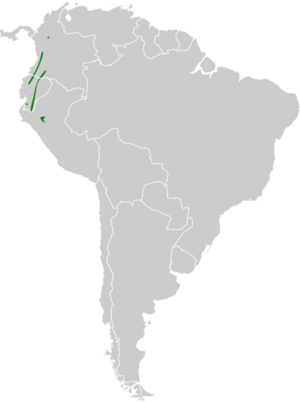Orange-crested flycatcher facts for kids
Quick facts for kids Orange-crested flycatcher |
|
|---|---|
 |
|
| and Orange-crested flycatcher seen in Zamora-Chinchipe, Ecuador | |
| Conservation status | |
| Scientific classification | |
| Genus: |
Myiophobus
|
| Species: |
phoenicomitra
|
 |
|
The orange-crested flycatcher (Myiophobus phoenicomitra) is a small, colorful bird. It belongs to the Tyrannidae family, which includes many flycatchers. You can find this bird in parts of Colombia, Ecuador, and Peru. It likes to live in moist montane forests, which are forests found on mountains.
Contents
What Does the Orange-crested Flycatcher Look Like?
The orange-crested flycatcher is a tiny bird. It usually weighs about 10 to 11 grams. That's about the same as two quarters!
Its body is mostly olive green. Its tail and wings are a darker brown color. You might also see faint yellowish-brown stripes on its wings. This bird has a short, light-colored beak and dark eyes. It also has a faint ring around its eye.
The Hidden Crest
The male orange-crested flycatcher has a special orange crest on its head. This crest is usually hidden. It's not often seen when the bird is just sitting around. This makes it harder to spot this cool feature in the wild.
Spotting the Difference
There's another bird called the Flavescent flycatcher that looks similar. But you can tell them apart! The Flavescent flycatcher has a broken eye-ring. It also has a black beak, not a light-colored one.
What Does it Sound Like?
The orange-crested flycatcher has a unique call. Some people say it sounds like "sit-sit-sit-still." Others describe it as "sit-sweet-sit."
Where Do Orange-crested Flycatchers Live?
These birds live in the Andes mountains. They are found in three main areas. These areas are separate from each other.
One group lives on the western side of the Andes. You can find them in central Colombia and northwestern Ecuador. This group is known as M. p. litae.
Another group lives on the eastern side of the Andes. They range from southern Colombia, through eastern Ecuador, to northern Peru. This group is called M. p. phoenicomitra.
There is also a third, smaller group. They live in a specific area around Chachapoyas Province in Peru.
How Scientists Study and Name Birds
Scientists give every animal a special two-part name. This helps everyone know exactly which animal they are talking about. The orange-crested flycatcher's scientific name is Myiophobus phoenicomitra.
This bird was first described in 1885. Two scientists, Władysław Taczanowski and Hans von Berlepsch, gave it its first name. They called it Myiobius phoenicomitra. Later, scientists decided it fit better in a different group, or genus. So, they moved it to the Myiophobus genus.


